-- JonathanMo - 14 Sep 2015
Trade marks and geographical indications (GIs)
TRIPS obligations
In accordance with the requirements of the TRIPS Agreement, WTO members are required to provide legal means to prevent use of any designation or presentation which may mislead the public as to the geographical origin of a good, and use which constitutes an act of unfair competition within the meaning of Article 10bis of the Paris Convention. Members are also required to refuse or invalidate the registration of a trade mark which uses a geographical indication (GI) for goods not originating in the territory indicated, if the indication is used in such a manner that it may mislead the public as to the true place of origin of the goods. Article 23 of TRIPS requires members to provide an additional level of protection to wines and spirits, and in particular to provide the legal means for preventing use of a GI identifying wines or spirits not originating in the place indicated by that geographical indication, even where the true indication of origin is indicated, where the indication is given in a translated form, or where it is qualified. Accordingly, unlike the status in respect of other geographical indications, those for wines and spirits are to be protected even where use by a third party would not mislead the public and unfair competition would not exist. In France, a government agency validates Appellation d'Origine Contrôlée (registered designations of origin), so that producers of wines, cheeses, and other foodstuffs, whose goods are renowned for their distinctive qualities and geographic origins are protected. For example, wines from the Champagne region of France are protected this way; local producers acting collectively have prevented the use of the word 'Champagne' on any sparkling wine that does not originate from the Champagne region of France.The TMA and GI protection
Australia goes some way to meeting its obligations under TRIPS by incorporating in the TMA a certain degree of protection against the inappropriate usage of geographical indications (GIs) as trade marks. Section 6 of the TMA defines a GI as a sign recognised in the country of origin of certain goods which indicates that the goods: (a) originated in that country or region; and (b) have a quality, reputation, or other characteristic attributable to their geographical origin. The general requirements of 'distinctiveness' make a GI difficult to register, although there is no express prohibition of their registration. Section 61 of the TMA provides that a registration of a trade mark may be opposed on the grounds that it constitutes a false indication of the geographical origins of the goods or services to which it applies. See Clark Equipment Co v Registrar of Trade marks [1964] HCA 55; (1964) 111 CLR 511 (High Court). Furthermore, any false GI in relation to grape products may also render the mark unregistrable under section 42 of the TMA (where its use would be 'contrary to law'). See Comite Interprofessionnel des Vins Cotes de Provence v Stuart Alexander Bryce [1996] 742 FCA 1. Copyright © by the contributing authors. All material on this collaboration platform is the property of the contributing authors.
Copyright © by the contributing authors. All material on this collaboration platform is the property of the contributing authors. Ideas, requests, problems regarding AustLII Communities? Send feedback
This website is using cookies. More info.
That's Fine

